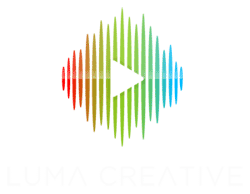How to conduct an interview for video production
There are many different types of Bay Area video production that we offer at Luma Creative. From commercials to explainer videos and everything in between, we shoot nearly everything. Some of our videos require interviews, so we feel we’ve gotten pretty good at capturing the content we need to make the video a success. One of the most common questions we get is regarding our professional tips on how to conduct an interview on video. There are many different styles of interviews such as documentary interviews, corporate, or video journalism. Below are some universal tips that we wanted to share for your next interview:
- Know Your Purpose – Make sure that you are clear with the goals of your end deliverable or video piece. You should know the overall story you are looking to get out of the interview before it begins. Leave some room for discovery but ultimately, you are responsible for getting the soundbites that will make your video come to life.
- Choose the Right Interviewee. Pick someone who will represent your purpose, who is articulate, comfortable on camera, and has all the questions in advance so they can prepare. Often times it also helps to hop on a pre-interview call to connect with them and make sure they are setup for success. Most people are not used to be on camera, so making them feel comfortable before arriving can go a long way. With our crowdfunding videos, it’s often the first time someone is on camera so it can be easy for them to get nervous! Looking for some preparation tips for your talent? You can send them this article on preparing for an on-camera interview.
- Do Your Research – It’s important to be able to think on your feet. Have an understanding of the subject before you sit down with them. This means being informed on the subject and knowing the right questions to ask. Sure you could use a teleprompter for your subject, but often times this feels staged or too rehearsed.
- Have a proper crew – When learning how to conduct an interview for video production, it’s important to remember this is a team activity. It’s ideal to always have an interviewer next to the Videographer, so the videographer can focus on the shot/sound and the interviewer can focus on the content. You always want to make sure the lens is perfectly aligned so when the interviewer answers the questions, it looks like the eyes of the subject are aligned in the shot, vs looking shifty or all over the place. Another tip can be to use an eye direct, which allows your interviewer to be a bit further away and have the interviewee look directly into the lens to see them.
- Light Your Subject – We can’t stress this enough. Lighting is everything and will set up the mood. The interview won’t be useable if the light looks too dramatic or the subject hates how they look. We will often show the subject their shot, so they approve it verbally. You’ll need at least two lights, preferably three. A soft source is best for your subject, a second light for the background, and a third for either fill light, hair light, or a side light (variously called an “edge” light or “rim” light)
- Test Your Sound – Audio is everything. Not only should you be recording sound in multiple ways, but you should be monitoring it throughout. We often times will use both a lav mic, hidden under the subjects clothing as well as a boom mic. This will give you a few options in case one doesn’t sound ideal.
- Prepare, but be spontaneous. Go into the interview with a plan. What sound bytes are you looking to get out of the interview? Once you’ve got the soundbites you need, feel free to ask the subject if they have anything to add or if there is anything they think that they missed.
- Get the interviewee comfortable. I can not stress enough how building a rapport is essential to the success of the footage. Do they need any water? How has their day been so far?
- Have the subject repeat your question when they answer. Avoid “yes” or “no” answers. This way when you cut yourself out of the interview, they’ll set up their answer for you!
- Keep your mouth shut when the subject talks. Or if the subject starts talking when the interview question is not complete, you need to have them repeat so the editor has footage they can work with. Yes it is a conversation, but at the same time, keep the edit in mind?
Do you have any thoughts on how to conduct an interview for video production If so, let us know! We are a San Francisco video production company who will take your production to the next level! Contact us today!

